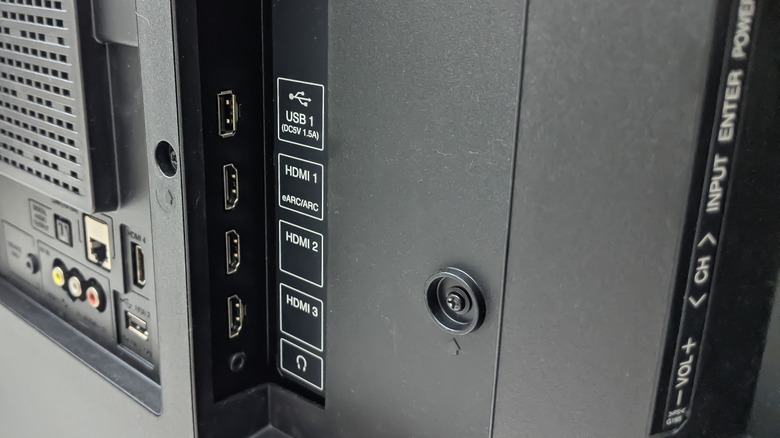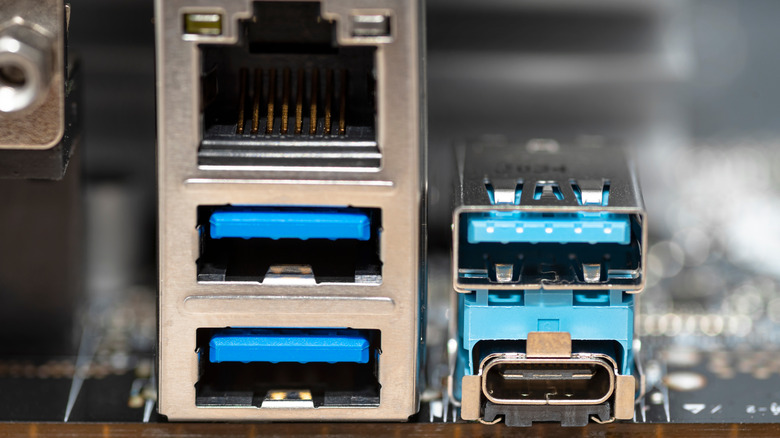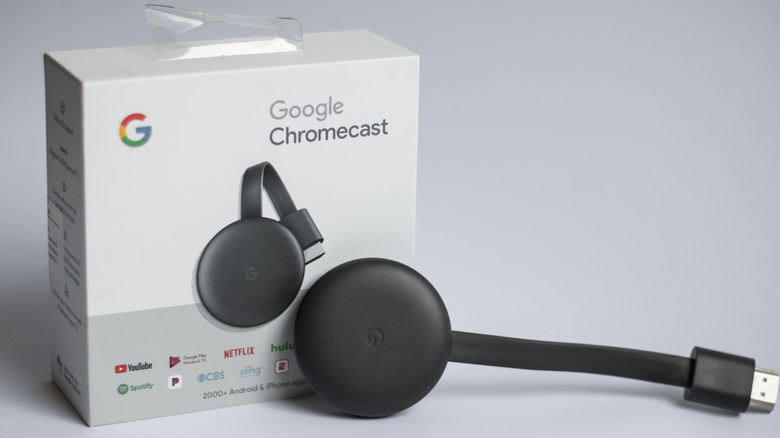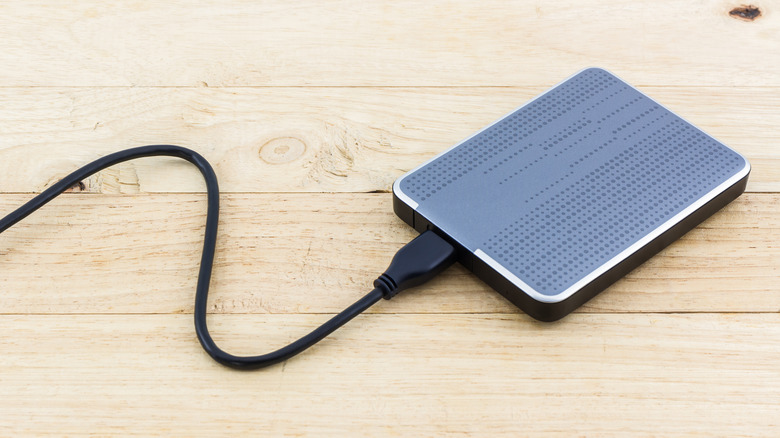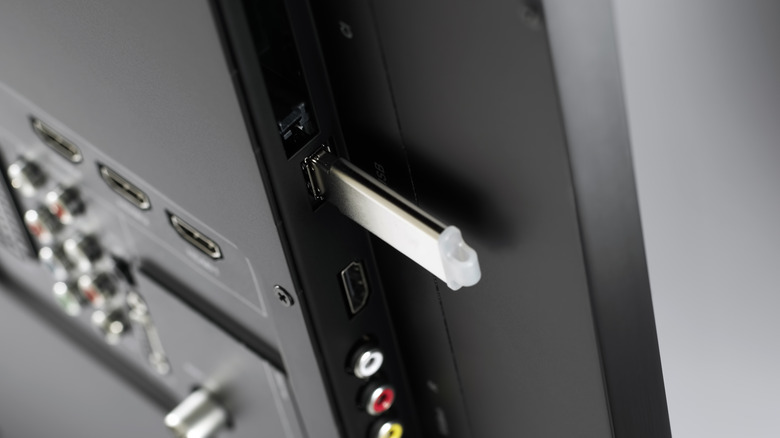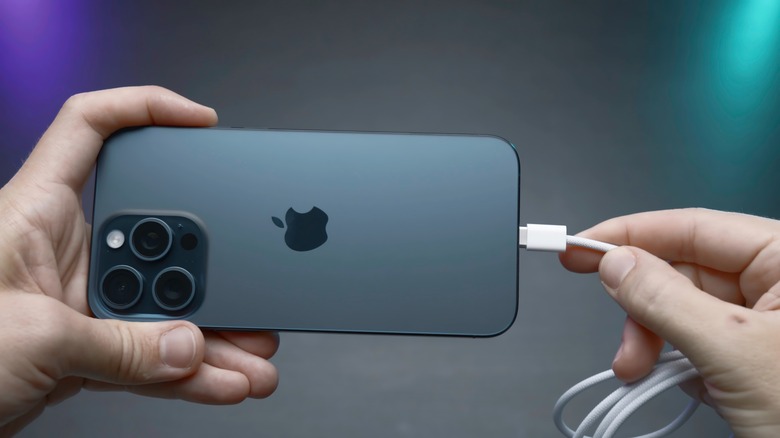5 Ways To Use Your TV's USB Ports
We may receive a commission on purchases made from links.
While television has been around for over a century, its role in our households and workplaces have changed dramatically. In the past, TVs were vehicles for entertainment and broadcasting news. However, these days, we have many other alternative methods of information dissemination, especially with the ubiquity of smartphones and smart home devices with displays, like the Amazon Echo Show.
In recent times, many modern TVs have multiple ports that help optimize connectivity, such as the HDMI port, LAN port, and so on. But before smart television screens were as affordable or accessible as they are today, many of us relied on the use of Universal Serial Bus (USB) ports to get the same experience.
But, before we can get into how to make the most of your TV's USB ports, it's important to know that not all of them are made equally. Here are all the ways your USB ports can be different and how it may affect where and how you're able to use them.
What type of USB port is on your TV and why does it matter?
Through the years, there have been several generations of USB ports, such as the USB 1.X, USB 2.X, USB 3.X, USB 4, and the many variations in between. In recent times, there have been massive leaps in USB technology, leading to improved data transfer rates and power capabilities that can impact what USB ports in general are capable of.
While there are different ways to tell apart each USB generation, like counting the number of pins, it's not always apparent unless you're willing to manually test it. However, when it comes to TVs, most of them use the standard USB 2.0 port, which has a 480 Mbit/s transfer speed, a maximum current of 0.5A, 2.5W power, and a maximum voltage of 5V.
Depending on your TV model, the transfer rates and power output may vary, so you'll need to check your TV's manual, the port itself, or consult the manufacturer's website to verify it. In some cases, such as with the 2023 Samsung 4K/8K TVs, they will have multiple USB ports that offer different specifications, such as 0.5A or 1A ports.
In addition, there are also other factors that can affect whether you can make full use of the USB port features, such as the quality of your USB cable and the compatibility of the device you're trying to connect. Once you have all the necessary information, here are a few ways to use your USB ports today.
Power your streaming media players
Although many modern TVs have built-in capabilities to stream directly, there are plenty of reasons you might still want to use streaming sticks even with a smart TV. For example, using a streaming stick adds a layer of protection from possible security threats, can let your TV work in tandem with existing smart home devices in your home, and can unlock a wider range of content providers.
If you don't have enough sockets, plugs, or extension cords to supply power to your peripheral, you may be able to use your TV's USB port. For example, if you own the Philips 65OLED808 Ultra HD (4K) TV or any TV that has a USB 3.0 port that is able to generate up to 4.5W (or 5V, 900 mA) , you might be able to use streaming sticks with lower energy consumption. In its smart plug power consumption test, How-To Geek shares that there are several streaming sticks that don't reach 4.5W, such as the Chromecast Ultra, Chromecast with Google TV, and Fire TV 4K.
That said, companies like Google don't recommend powering specific streaming devices, like its Chromecast Ultra, with your TV USB port, and state the importance of using the right power supply (via its included plug). While it can work for some time, you might encounter warnings due to the streaming stick not getting enough power. Because of this, you'll need to review your TV's hardware specs for any special instructions and manage your expectations.
Play media via external storage
When you're keen to share family videos or vacation photos from a thumb drive during a get-together, a large-screen TV is a much cooler and more engaging way to display them to a lot of people all at once. If you used a camera to take them, you might need a USB dock to read the SD card. In some cases, if you're trying to watch an old school movie that is still on a DVD, you could require an external player that uses a USB connector such as the LG WP50NB40 USB DVD player, which lets you watch DVD's and Blu-ray Discs simply by plugging in the cable.
While there are a bunch of other ways to play media from your computer or mobile phone, the benefit of a direct or wired connection is that there is a more stable and physical connection. However, should you plan to use a flash drive or external hard drive to play media on your TV via USB port, it's important to consider if you're using the correct format. Depending on your file sizes, MediaZilla recommends using FAT32 (less than 4 GB) or exFAT or NTFS (over 4 GB).
In addition, you also have to take into account if the file types you want to play are compatible with your specific TV model. For example, the Samsung QLED TV can read over 30 file types for images, audio, and video, which include JPEG, PNG, MP3, AAC, MP4, and MOV.
Firmware updates and software debugging
Despite all its advantages, there are still many reasons why not everyone wants a smart TV. Similar to other devices connected to the internet, smart TVs aren't immune from being compromised by bad actors. In 2024, Bitdefender claimed that it had found several security issues for over 91,000 LG TVs, which allowed hackers multiple ways to gain access to your device, including adding themselves as another user and bypassing authentication procedures. Thankfully, LG confirmed that a software update was released to resolve these concerns soon after (via TechRadar).
Aside from security issues, TV software updates are also a great way for manufacturers to introduce enhanced features, functional changes, and aesthetic updates, even for older TV models. For many smart TV models, you can update your software directly on your screen, but if your TV is having issues with your internet connection, you can often opt to update your TV with a USB instead.
To know if your TV is in need of a software refresh, open the Settings menu and locate the software update section, which will vary per brand. For Samsung TVs, you can find this under the Settings' Support section. Afterwards, go to the manufacturer's website, download the update onto a USB stick or external hard drive, and then connect it to your TV. For reference, Samsung TV owners can find the latest updates in the Samsung Download Center, while Sony TV owners can check the Sony Support website.
Charge electronic devices
Have you ever found yourself in a hotel room with not enough plugs for everyone or not the right kind of plugs for the country you're visiting? Well, if there's a TV with a USB port in the room, you're in luck. If you're looking for a quick way to juice up, the 5V power supply is pretty common for small electronics no matter where you are in the world, especially for things like tablets and smartphones.
However, it's important to note that larger and more complex systems might need higher voltage electrical systems, so this can limit what devices you can hope to charge with just your TV's USB port. Unfortunately, this means if you need to charge the batteries of your Sony digital camera, you're going to need a proper 12V plug.
It's important to note that charging your phone (or other electronics) with anything not designed to do so can carry some additional risk — because they're not tested to work with your particular device. For example, improper voltage regulation can lead to your phone's internal components and battery being damaged permanently. In addition, some smartphone manufacturers, including Samsung and Apple, state that any damage caused by third-party or unofficial charging cables or bricks can invalidate your existing warranty.
Connecting peripheral devices and accessories
Playing games or browsing via your TV's native web browser can be a nightmare, and while there are a lot of Bluetooth options out there, many gamers will know that sometimes wired is better, simply because wired controllers reduce the risk of lag or latency that can make or break a game. Thankfully, many smart TVs let you connect peripherals, like a keyboard and mouse, via USB, as well.
That said, you may encounter some compatibility issues with some peripherals, especially if they're not designed to work with TVs. Thankfully, some manufacturers like LG have released recommended models for their TVs, like several Logitech keyboards (K360, K400, and 750) and the LG MKS-1200. Plus, if you're into gamepads, LG also shared that the wired Microsoft Xbox 360 controller and the Sony PlayStation 3 controller have been tested for compatibility.
Lastly, you might also want to connect other accessories to your TV to enhance your viewing experience. For example, you may want to add some funky LED lights to help add some spice to your favorite TV or movie scenes. If you're not sure how to start, you can check out our review of the Philips Hue Play HDMI Sync Box for some inspiration.
